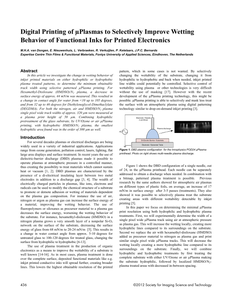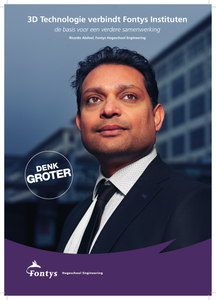This is the first draft of the large scale 3d printing protocol for granulated thermoplastics. The main purpose of this document is to share the key steps of operating, preparation, data entry, and optimization procedures while handling the robotic 3d printing equipment. One main aspect of this protocol is that it is independent of specific 3d printing hardware or software setups. The aim is to have the users from robotic 3d printing from various technologies follow these steps and be able to set the basics up when it comes to handling such 3d printers.
DOCUMENT

The additive manufacturing (AM) of high-quality products requires knowledge of the 3D-printing process and the related design guidelines. Allthough AM has been around for some years, many engineers still lack this knowledge. Therefore, Fontys University of Applied Sciences sets great store by training of engineers, education of engineering students and knowledge sharing on this topic. As an appetiser, this article offers a beginner’s course.
DOCUMENT

In this article we investigate the change in wetting behavior of inkjet printed materials on either hydrophilic or hydrophobic plasma treated patterns, to determine the minimum obtainable track width using selective patterned μPlasma printing. For Hexamethyl-Disiloxane (HMDSO)/N2 plasma, a decrease in surface energy of approx. 44 mN/m was measured. This resulted in a change in contact angle for water from <10 up to 105 degrees, and from 32 up to 46 degrees for Diethyleneglycol-Dimethaclylate (DEGDMA). For both the nitrogen, air and HMDSO/N2 plasma single pixel wide track widths of approx. 320 μm were measured at a plasma print height of 50 μm. Combining hydrophilic pretreatment of the glass substrate, by UV/Ozone or air μPlasma printing, with hydrophobic HMDSO/N2 plasma, the smallest hydrophilic area found was in the order of 300 μm as well.
DOCUMENT

In manufacturing of organic electronics, inkjet printing as an alternative technique for depositing materials is becoming increasingly important. Aside to the ink formulations challenges, improving the resolution of the printed patterns is a major goal. In this study we will discuss a newly developed technique to selectively modify the substrate surface energy using plasma treatment as a means to achieve this goal. First, we look at the effects of the μPlasma treatment on the surface energy for a selection of plastic films. Second, we investigated the effects of the μPlasma treatment on the wetting behaviour of inkjet printed droplets to determine the resolution of the μPlasma printing technique. We found that the surface energy for all tested films increased significantly reaching a maximum after 3-5 repetitions. Subsequently the surface energy decreased in the following 8-10 days after treatment, finally stabilizing at a surface energy roughly halfway between the surface energy of the untreated film and the maximum obtained surface energy. When μPlasma printing lines, an improved wetting abillity of inkjet printed materials on the plasma treated areas was found. The minimal achieved μPlasma printed line was found to be 1 mm wide. For future application it is important to increase the resolution of the plasma print process. This is crucial for combining plasma treatment with inkjet print technology as a means to obtain higher print resolutions.
DOCUMENT

Inkjet printing is a rapidly growing technology for depositing functional materials in the production of organic electronics. Challenges lie among others in the printing of high resolution patterns with high aspect ratio of functional materials to obtain the needed functionality like e.g. conductivity. μPlasma printing is a technology which combines atmospheric plasma treatment with the versatility of digital on demand printing technology to selectively change the wetting behaviour of materials. In earlier research it was shown that with μPlasma printing it is possible to selectively improve the wetting behaviour of functional inks on polymer substrates using atmospheric air plasma. In this investigation we show it is possible to selectively change the substrate wetting behaviour using combinations of different plasmas and patterned printing. For air and nitrogen plasmas, increased wetting of printed materials could be achieved on both polycarbonate and glass substrates. A minimal track width of 320 μm for a 200 μm wide plasma needle was achieved. A combination of N2 with HMDSO plasma increases the contact angle for water up from <100 to 1050 and from 320 to 460 for DEGDMA making the substrate more hydrophobic. Furthermore using N2-plasma in combination with a N2/HMDSO plasma, hydrophobic tracks could be printed with similar minimal track width. Combining both N2 -plasma and N2/HMDSO plasma treatments show promising results to further decrease the track width to even smaller values.
DOCUMENT

De wereld verandert in een razend tempo. Technologische ontwikkelingen hebben een grote impact op mens en maatschappij. Het verandert niet alleen onze manier van werken maar ook onze manier van leven. Steeds meer disciplines hanteren technologie als basis om in een professionele omgeving het werk kwalitatief beter, sneller en effi ciënter uit te voeren. Digitalisering, globalisering en informatisering maakt het mogelijk om plaats- en tijdonafhankelijk te studeren en te werken. Fontys Hogescholen speelt hier op in door tal van initiatieven te ondersteunen die gericht zijn op het volgen van deze en opkomende trends rondom technologische ontwikkelingen en de impact voor het onderwijs. Met het Fontys Objexlab zetten we deze beweging door. Opkomende technologieën zoals 3D printing en Robotica maken we graag toegankelijk voor collega’s. Andere instituten kunnen hiervan gebruik maken zodat zij hun onderwijs nog aantrekkelijker en actueler kunnen maken. In het najaar van 2014 zijn we gestart met het samenbrengen van collega’s van verschillende instituten en opleidingen om enerzijds deze nieuwe technologieen te leren en te ervaren, om daarna een stap te maken in het initiëren van ideeën en plannen om met deze kennis en vaardigheden onderwijsvernieuwing gezamenlijk vorm- en inhoud te geven.
MULTIFILE

Anyone who has watched a child play with soft semi-liquid materials like honey, frosting, or slime, sees the fascinating interplay between design and physics. Many of us remember these experiences from our own childhood (or maybe not that long ago). These materials dribble and coil as they stack upon themselves when we drop them onto surfaces like cakes from small heights. This ludic behavior represents a physical phenomenon known as rope coiling. Recent research in 3D printing of clay and plastic has started to wonder how rope coiling can be leveraged to create new textures and textile-like structures through non-planar 3D Printing. These provide new tactile experiences in objects like cups and visual experiences in things like lamps. In this demonstrator, we invite researchers and practitioners to return to their childhood and dribble edible materials to understand how to advance additive manufacturing through interactive printing.
DOCUMENT

Het boek ‘3D Printing with biomaterials’ introduceert een manier om een duurzame en circulaire economie te realiseren; 3D printen gecombineerd met het gebruik van biomaterialen.
DOCUMENT

Many articles have been published on scale-down concepts as well as additive manufacturing techniques. However, information is scarce when miniaturization and 3D printing are applied in the fabrication of bioreactor systems. Therefore, garnering information for the interfaces between miniaturization and 3D printing becomes important and essential. The first goal is to examine the miniaturization aspects concerning bioreactor screening systems. The second goal is to review successful modalities of 3D printing and its applications in bioreactor manufacturing. This paper intends to provide information on anaerobic digestion process intensification by fusion of miniaturization technique and 3D printing technology. In particular, it gives a perspective on the challenges of 3D printing and the options of miniature bioreactor systems for process high-throughput screening.
LINK
This study explores the shape-morphing behavior of 4D-printed structures made from Polylactic Acid (PLA), a prominent bio-sourced shape-memory polymer. Focusing on the response of these structures to thermal stimuli, this research investigates how various printing parameters influence their morphing capabilities. The experimental approach integrates design and slicing, printing using fused deposition modeling (FDM), and a post-printing activation phase in a controlled laboratory environment. This process aims to replicate the external stimuli that induce shape morphing, highlighting the dynamic potential of 4D printing. Utilizing Taguchi’s Design of Experiments (DoE), this study examines the effects of printing speed, layer height, layer width, nozzle temperature, bed temperature, and activation temperature on the morphing behavior. The analysis includes precise measurements of deformation parameters, providing a comprehensive understanding of the morphing process. Regression models demonstrate strong correlations with observed data, suggesting their effectiveness in predicting responses based on control parameters. Additionally, finite element analysis (FEA) modeling successfully predicts the performance of these structures, validating its application as a design tool in 4D printing. This research contributes to the understanding of 4D printing dynamics and offers insights for optimizing printing processes to harness the full potential of shape-morphing materials. It sets a foundation for future research, particularly in exploring the relationship between printing parameters and the functional capabilities of 4D-printed structures.
DOCUMENT
